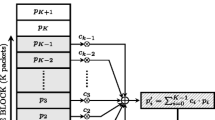Abstract
In this paper, we propose INCP, inter-flow network coding protocol, for wireless mesh networks. INCP is designed with the concept of Layered Approach. It acts as a distinct layer above the MAC and has close cooperation with IP layer. INCP exploits the opportunities of network coding through multiple unicast sessions to decrease the number of transmissions, thereby increasing the aggregated throughput. Unlike most prior work that is mainly theoretical, INCP addresses the practical issues of network coding such as impact of lossy links, enabling/disabling RTS/CTS mechanism, packet size and its variation. We consider a retransmission mechanism to ensure a reliable broadcasting. We analyze the cost of this approach by providing a theoretical formulation for the amount of required bandwidth for successful broadcasting a coded packet to n neighbors. Further, we examine the coding gain for lossy networks by considering the ETX metric for routing in addition to traditionally shortest-path metric. The results, implemented in ns-3, show that not only INCP increases network throughput, but also improves the fairness of the IEEE 802.11 MAC. Moreover, the gain for real MAC is greater than the theoretical gain in most cases. The performance gain of INCP reaches up to several folds depending on the traffic model and congestion level.














Similar content being viewed by others
References
Katti, S., et al. (2008). XORs in the air: Practical wireless network coding. IEEE/ACM Transactions on Networking (TON), 16(3), 497–510.
Sengupta, S., Rayanchu, S., & Banerjee, S. (2010). Network coding-aware routing in wireless networks. IEEE/ACM Transactions on Networking, 18(4), 1158–1170.
Shafieinejad, A., Hendessi, F., & Fekri, F. (2013). Star-structure network coding for multiple unicast sessions in wireless mesh networks. Wireless Personal Communications, 72(4), 2185–2214.
De Couto, D. S. J., Aguayo, D., Bicket, J., & Morris, R. (2003). A high-throughput path metric for multi-hop wireless routing. In Proc. ACM MOBICOM 2003 (pp. 134–146).
Subramanian, V., et al. (2006). Impact of interference and capture effects in 802.11 wireless networks on TCP. In Proceedings of the second international workshop on wireless traffic measurements and modeling. ACM.
Han, M. K., et al. (2011). O3: optimized overlay-based opportunistic routing. In Proceedings of the twelfth ACM international symposium on mobile ad hoc networking and computing. ACM.
Le, J., Lui, J. C. S., & Chiu, D.-M. (2010). DCAR: distributed coding-aware routing in wireless networks. IEEE Transactions on Mobile Computing, 9(4), 596–608.
Zhang, J., Chen Y. P., & Marsic, I. (2008). Network coding via opportunistic forwarding in wireless mesh networks. In Wireless communications and networking conference, 2008 (WCNC 2008). IEEE.
Zhang, J., Chen, Y. P., & Marsic, I. (2010). MAC-layer proactive mixing for network coding in multi-hop wireless networks. Computer Networks, 54(2), 196–207.
Shafieinejad, A., Hendessi, F., & Fekri, F. (2013). Network coding for multiple unicast sessions in multi-channel/interface wireless networks. Wireless Networks, 19(5), 891–911.
Nguyen, D., et al. (2009). Wireless broadcast using network coding. IEEE Transactions on Vehicular Technology, 58(2), 914–925.
Johnson, D. B., Maltz, D. A., & Broch, J. (2001). DSR: The dynamic source routing protocol for multi-hop wireless ad hoc networks. Pittsburgh, PA: Computer Science Department Carnegie Mellon University.
Friis, H. T. (1946). A note on a simple transmission formula. Proceeding of the IRE, 34(5), 254–256.
Rappaport, T. S. (2002). Wireless communications principles and practices. Englewood Cliffs: Prentice-Hall.
ns-3 documentation. http://www.nsnam.org.
AMPL: A modeling language for mathematical programming. http://www.ampl.com/. IBM Inc.
CPLEX, ILOG. http://www.ilog.com. ILOG Inc.
Jain, R., Chiu, D. M., & Hawe, W. (1984). A quantitative measure of fairness and discrimination for resource allocation in shared computer systems. DEC Research Report TR-301.
Author information
Authors and Affiliations
Corresponding author
Rights and permissions
About this article
Cite this article
Shafieinejad, A., Motamedi, N., Hendessi, F. et al. INCP: Practical Wireless Network Coding for Multiple Unicast Sessions. Wireless Pers Commun 91, 623–651 (2016). https://doi.org/10.1007/s11277-016-3484-5
Published:
Issue Date:
DOI: https://doi.org/10.1007/s11277-016-3484-5




